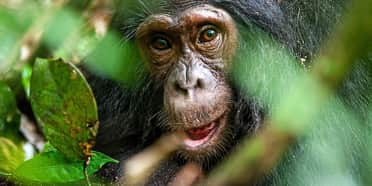- You are here:
- Home
- Countries & Parks
- Uganda Parks
- Bugoma Forest Reserve
Overview – Bugoma FR

Philip is a renowned Africa expert and author of many guidebooks to African destinations, including the Bradt guide to Uganda.
Philip is a renowned Africa expert and author of many guidebooks to African destinations, including the Bradt guide to Uganda.
Philip is a renowned Africa expert and author of the Bradt guidebook to Uganda.
Philip is the author of the Bradt guidebook to Uganda.
Bugoma Forest Reserve, created in 1932, is one of Uganda’s oldest but most neglected protected areas. A key migratory corridor between Murchison Falls National Park and the Semliki Valley, it supports a wealth of forest primates and birds, including 550-plus chimpanzees. In recent years, it has been a battleground between developers wanting to clear it for sugarcane plantations and environmental campaigners opposed to this. For anyone familiar with this aspect of the forest’s history, it is heartening to learn that Bugoma opened as a chimpanzee trekking site in 2024.


Pros & Cons
- Uganda’s newest and most off-the-beaten-track chimp trekking site
- Forest monkeys include the endemic Uganda mangabey
- Good forest bird watching with some 260 species recorded
- Easily visited en route to Murchison Falls coming from the capital Kampala or Fort Portal
- It can be explored from the ecofriendly Bugoma Jungle Lodge on the forest edge or from nearby Hoima town
- Ecotourism is set to play an important role in the survival of this threatened forest
- Tourism is in its infancy and amenities are limited
- Chimp sightings are less reliable than at other better established trekking sites
Bugoma FR Safari Reviews
- Expert Rating
- Wildlife
- Scenery
- Bush Vibe
- Birding
- User Rating 0.0/5– 0 Reviews
- Wildlife
- Scenery
- Bush Vibe
- Birding
Wildlife
Despite its low profile, Bugoma is one of Uganda’s most important chimpanzee strongholds. Indeed, its population of 550-plus chimps represents more than 10% of the national total. Other primates include black-and-white colobus, red-tailed monkey, blue monkey, olive baboon and the endemic Uganda mangabey. Of the Big Five, buffalo are present but seldom seen, while elephants pass through on occasion. A long list of alluring forest birds includes the glamorous great blue turaco and the localized white-thighed hornbill, rufous-sided broadbill, green-breasted pitta and black-eared ground thrush.
Scenery
Although Bugoma is not scenic in a conventional sense, this vast forest has a compelling jungle-like tropical African feel. Unfortunately, some areas have in the recent past been compromised by logging, land invasions and forest clearance. Despite this, it supports a rich floral biodiversity, with more than 224 trees and shrub species recorded, including some impressive specimens of Uganda ironwood (muhimbi), African mahogany and Guinea plum.
Activities
After a lengthy habituation process, chimpanzee trekking opened in Bugoma Forest in 2024. The success rate is not yet as high as in more established chimp trekking sites, but most visitors get lucky. The low number of tourists gives the excursion an exclusive feel. Other guided activities include nature walks (which focus on locating Uganda mangabeys and other monkeys), community visits and bird-watching excursions. A free self-guided 1.3km/0.8mi loop trail in the forested grounds of Bugoma Jungle Lodge offers a good chance of spotting monkeys and forest birds, including the iconic African grey parrot.
Weather & Climate
Bugoma Forest Reserve has a warm, humid climate with higher rainfall than most parks of Uganda. The driest months are January and February, with June, July and December also being relatively dry. Rainfall is highest over March to May and August to November. More info:
Best Time To Visit
Bugoma can be visited at any time of year and chimp trekking is always available. Conditions tend to be most favorable over the relatively dry months of January, February, June, July and December. At other times of year, forest trails may become waterlogged and rain is a possibility, but chimp trekking and other activities are still worthwhile. You may require a 4x4 vehicle to access the Mwera Ecotourism Site (the starting point for chimp trekking) after heavy rain.
Getting There
Bugoma Forest Reserve lies about 50km/31mi south of Hoima, a large town situated along the established route between the popular parks of southwestern Uganda and Murchison Falls. The route between the capital, Kampala, and Hoima is also increasingly popular now that it is surfaced almost in its entirety.
The drive from Hoima to Bugoma takes about 1 hour*. Coming from farther afield, allow at least 5 hours* for the 240km/149mi drive from Kampala, 4 hours* for the 150km/93mi drive from Fort Portal, or 3.5 hours* for the 170km/106mi from the Paraa Headquarters of Murchison Falls NP.
Chimp trekking starts at the Mwera Ecotourism Site, which lies alongside a dirt road that may require a 4x4 vehicle after heavy rain.
*Driving times are only a rough indication. You should always consider the possibility of significant delays.
Health & Safety
Please read our malaria and vaccinations page for Uganda, as well as our general ‘Wildlife Viewing Safety Precautions’ and ‘Chimp Trekking Safety Precautions’ below for more info:
- Malaria & Vaccinations – Uganda
- Wildlife Viewing Safety Precautions
- Chimp Trekking Safety Precautions
Want To Visit Bugoma FR?
Bugoma FR Safari Reviews
- Expert Rating
- Wildlife
- Scenery
- Bush Vibe
- Birding
- User Rating 0.0/5– 0 Reviews
- Wildlife
- Scenery
- Bush Vibe
- Birding
Most Helpful Expert Review

Charlotte lives in Uganda and is a writer, blogger, volunteer and promoter of birding, conservation and responsible tourism. She writes for Fodor’s, Horizon Guides and Bradt, and runs an award-winning blog.
Save Our Primates – Visit Bugoma!
If you’re a primate-lover, the 402km² Bugoma Forest Reserve has plenty to offer (minus the crowds you sometimes find at more established tracking sites across Uganda). One of the reserve’s key attractions is the Uganda mangabey, an...


 Uganda Parks
Uganda Parks